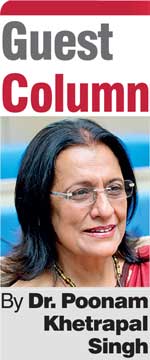Saturday Dec 14, 2024
Saturday Dec 14, 2024
Wednesday, 13 December 2017 00:00 - - {{hitsCtrl.values.hits}}
Ensuring all people everywhere have access to health services that are affordable, of good quality and within reach is a public health imperative. Whether to drive down maternal and child mortality, to halt rising rates of noncommunicable disease, or to prepare for and respond to public health emergencies, strong, accessible health systems are key to achieving the sustainable development agenda and securing health and wellbeing for all at all ages.
They are also critical to beating back the rapid advance of antimicrobial resistance (AMR), a problem caused by mutations in microorganisms – including bacteria – that then become resistant to even the most powerful antimicrobial and antibiotic drugs.
Though the battle against AMR across the WHO South-East Asia Region is being fought on many fronts – from optimising the use of antibiotics in the animal and agriculture sectors to investing in research and the development of new antibiotics – increased health coverage remains a powerful tool to counter AMR’s deadly menace and ensure our most precious drugs remain fit for purpose. This is so for a number of reasons.
First, increased access to health services – both prevention and treatment – boosts overall population health and  diminishes the spread of infectious bacteria. This is especially important for poor or marginalised populations, many of whom lack adequate sanitation and hygiene and are therefore at greater risk of bacterial infections. Where infections do occur, increased access to quality health services may result in the more rational use of antibiotics – a critical outcome given that unnecessary use of antibiotics accelerates AMR. At present an estimated two-thirds of antibiotics are consumed without prescription, in many cases inappropriately.
diminishes the spread of infectious bacteria. This is especially important for poor or marginalised populations, many of whom lack adequate sanitation and hygiene and are therefore at greater risk of bacterial infections. Where infections do occur, increased access to quality health services may result in the more rational use of antibiotics – a critical outcome given that unnecessary use of antibiotics accelerates AMR. At present an estimated two-thirds of antibiotics are consumed without prescription, in many cases inappropriately.
Second, better quality services can decrease health care-associated bacterial infections. Infections occurring in health facilities have an estimated prevalence of more than 10% in low and middle-income countries, meaning advances in antibiotic stewardship and infection control – including the provision of adequate water, sanitation and hygiene – have the potential to reduce this burden dramatically. In similar fashion, better quality antimicrobial drugs will help ensure bacteria are destroyed rather than given the chance to mutate, while access to advanced diagnostic tools will help health workers identify and treat infections more effectively.
And third, policies that make health care more affordable, including by reducing out-of-pocket expenditure, can help increase access to antimicrobial drugs when they are needed. At present an estimated 70% of out-of-pocket payments across the Region are on medicines, including antibiotics. This makes access to effective treatment unnecessarily costly for poorer people, who may then purchase and consume incomplete courses of antibiotics, hastening AMR. If accompanied by more stringent treatment guidelines and revised incentive schemes (for example de-linking the payment of health workers from the volume of drugs sold), cheaper antibiotics have significant potential to advance both the UHC and AMR agendas.
Importantly, one of the best ways to achieve this outcome is via the dissemination of high-quality information and advice to health workers and the general public. More and better information on the rational use of antibiotics will help health workers treat ailments more efficiently, while also helping relieve the pressure to prescribe antibiotics where their efficacy may be in doubt. At the same time, messaging that persuades the public that antibiotics aren’t the ‘cure-all’ they have come to be known as will help ensure they are sought-out only where necessary, reducing inappropriate consumption and the resistance it breeds.
On both UHC and AMR, the South-East Asia Region’s Member countries have made solid, mutually reinforcing progress. On UHC they have prioritised the strengthening of human resources for health, including the capacity of health workers at the primary level. They have also developed a regional regulatory network to help guarantee the quality of medicines, and have assessed health services coverage using a new WHO and World Bank index. On AMR, all Member countries have now developed and are implementing multisectoral national action plans, each of which emphasise the need for better infection control in health facilities, as well as enhanced public messaging on the rational use of antibiotics.
Progress on both fronts must continue. It should also be scaled up. By continuing to increase access to health services and striving to achieve universal health coverage, Member countries can further advance health and wellbeing for all, including by reversing the rising tide of antimicrobial resistance. And by continuing to implement multisectoral AMR national action plans, Member countries can help safeguard the efficacy of our most precious drugs, while at the same time advancing health equity and ensuring no one is left behind. When it comes to public health and development, universal goods can be hard to come by. Increased health coverage is one of them, and should be pursued accordingly.